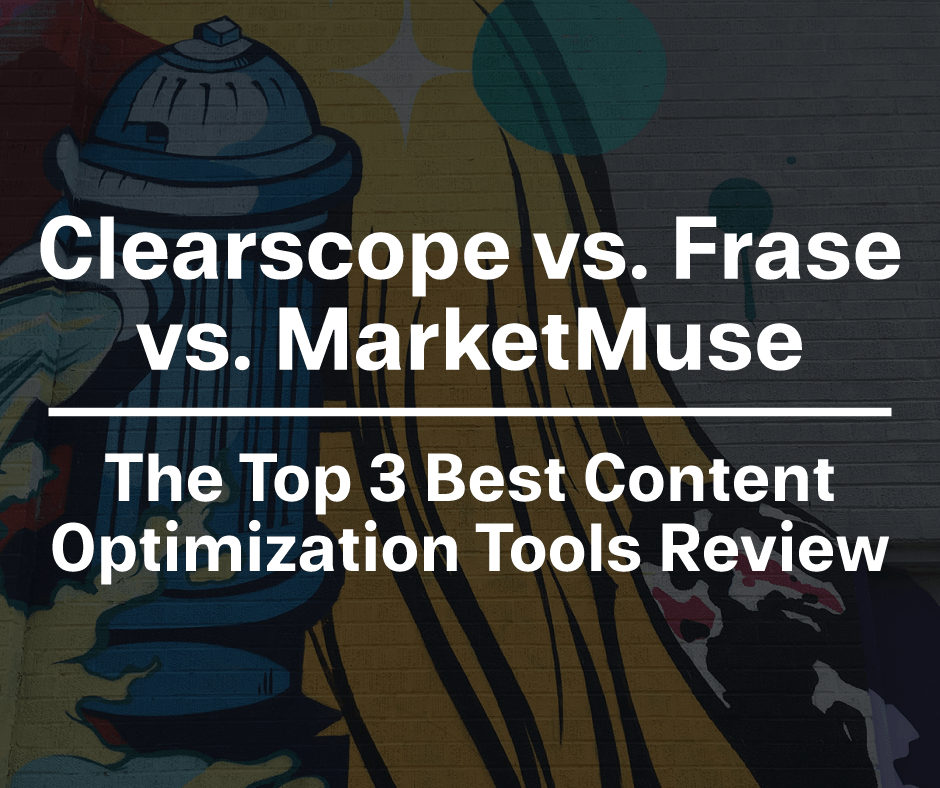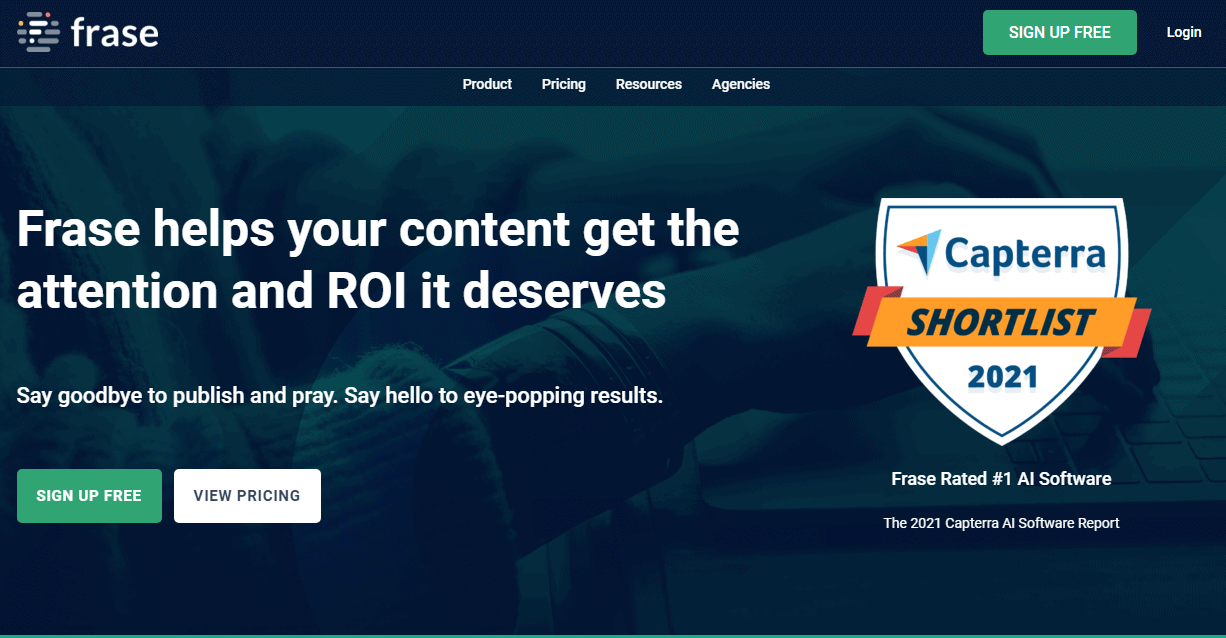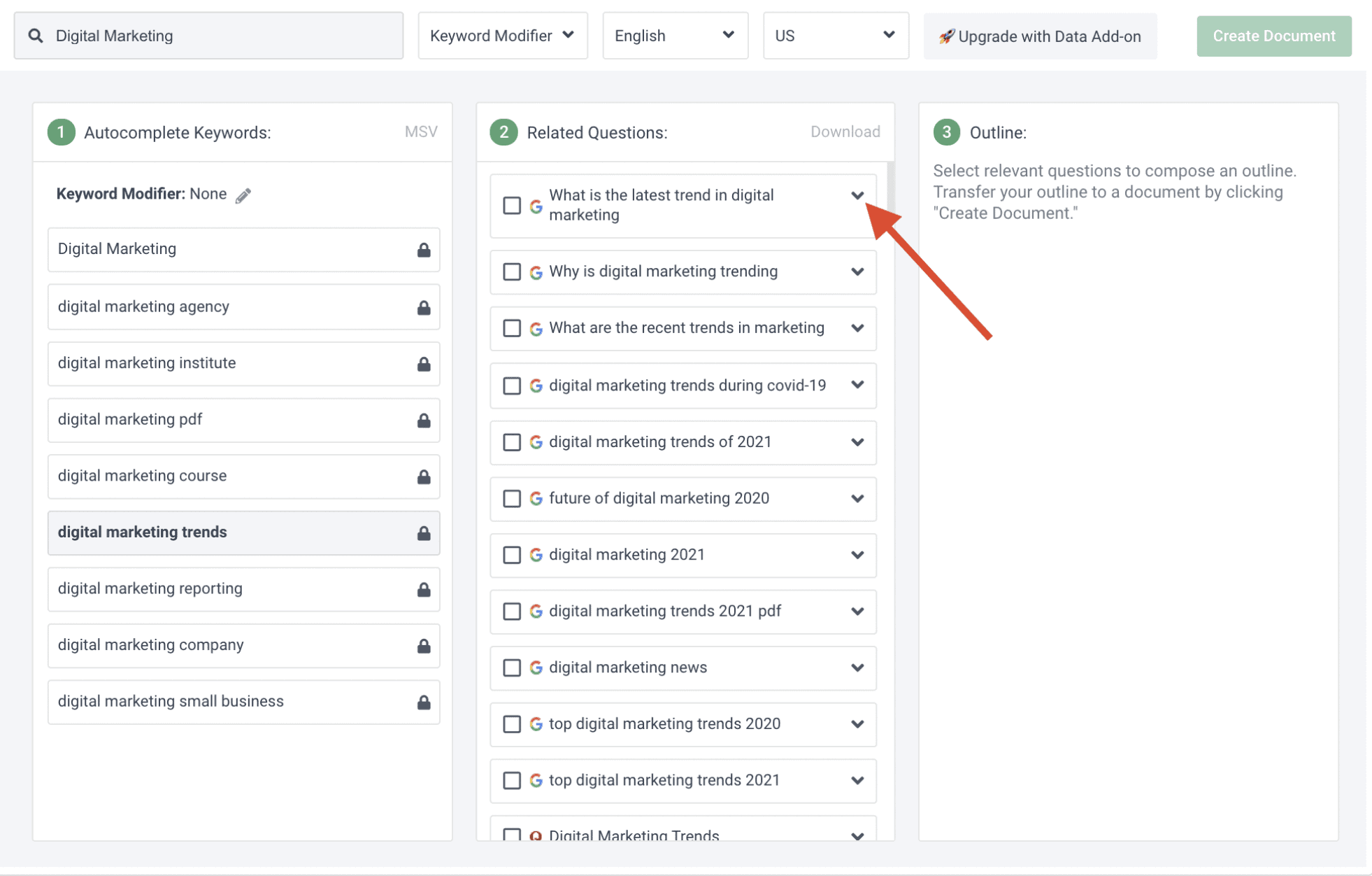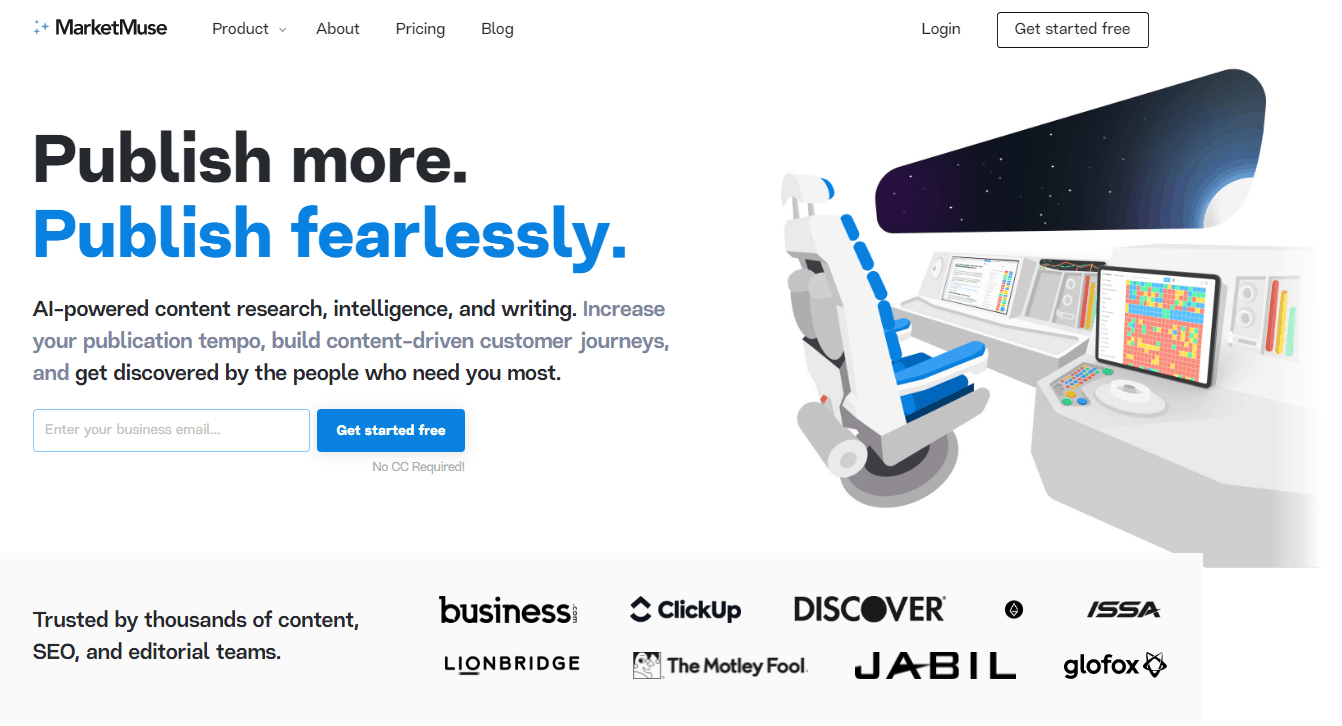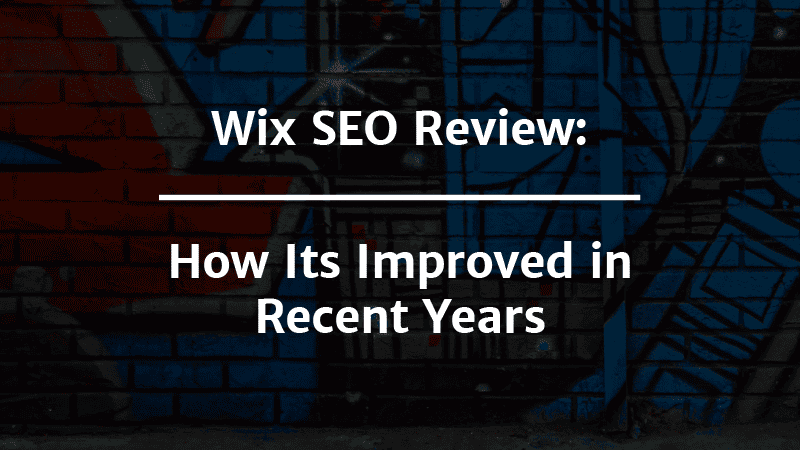These days, content optimization tools are all over the market, thanks to artificial intelligence (AI). But while this breakthrough is exciting, it also means you already have several tools to choose from.
Now it’s more challenging than ever to determine which tools are worth your money.
You might know that most content optimization software offers very similar features. They use Google’s natural language processing (NLP) system to analyze high-performing content and generate actionable recommendations.
But there’s a lot more to talk about. I’ll begin my overview of these content optimization tools by describing why they are important for SEO (search engine optimization).
Then, I’ll give you a side-by-side comparison of the three popular tools’ features, unique offerings, and whether you should choose just one or all of them.
Here’s what you’ll learn:
Why Use Content Optimization Tools
In 2019, Google released the BERT (Bidirectional Encoder Representations from Transformers) algorithm, one of its biggest updates. BERT’s “brain” uses NLP and can determine a word or phrase’s context and search intent based on various signals surrounding it.
That’s why SEOs realize NLP, machine learning language models, and AI-powered content optimization software are game-changers.
Content writers often look for these tools to create optimized content, with most experts recommending Clearscope, Frase, and MarketMuse as the top three content optimization tools.
If you’re on the fence about which of these tools you should use when you write content, then this guide is for you.
Frase is noted as the first Answer Engine Optimization platform, which helps you easily identify the questions your target audience is asking online. It is a content research and optimization software that automatically generates the most relevant content outlines and also provides a wide range of research sources.
Honestly, when I learned about AI-generated content and NLP analysis, Frase was one of the very first tools I was introduced to. Its tagline remains the same to this day: “SEO that will still work in 2030.”
Let’s take a look at what this content optimization tool currently offers.
Key Features
- Content Brief: After you put in the keyword/s, Frase will analyze search terms and immediately come up with a brief in less than a minute. All you need to do is click the sections you want to show.
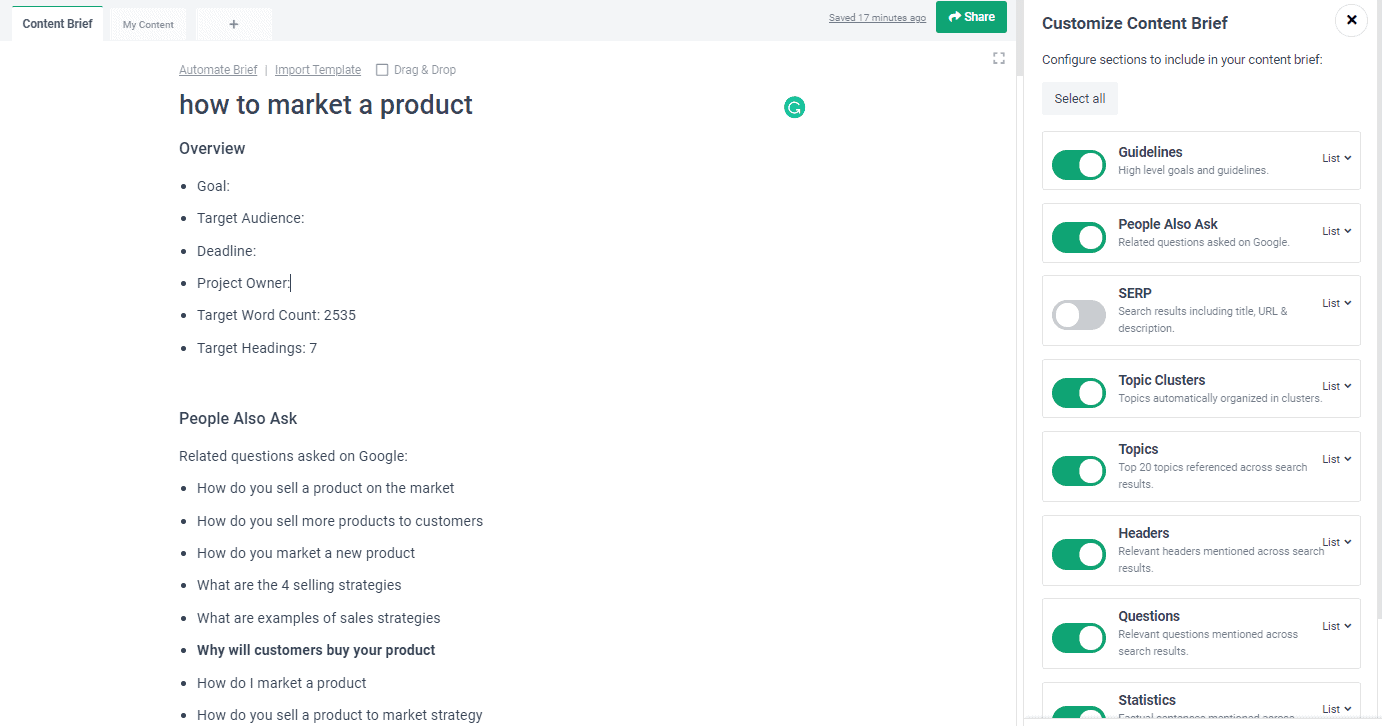
- Content Research: This feature provides useful resources to learn more about the topic when you start writing. You will find options for Question Ideas, Related Articles, Statistics, and News, which are helpful for external research material.
- Content Optimization: This helps you rate your content based on relevant terms from the top 20 ranking pages. You can see the competitor's header structure and topic clusters around the particular keyword.
One cool feature from this part is the Topic Heatmap, which gives you a clear strategy when writing your content as you can see what your competitors are missing.
It’s nice to see Frase taking this feature to the next level, as I was familiar with MarketMuse’s Topic Heatmap. In fact, Frase launched it last April 2021, which I was unaware of until just recently.
It is always a good practice to be on the lookout for new features of whatever content optimization software you are using.
- Outline Builder: With Frase’s SEO Tools feature, you can use the Outline Builder to see a keyword's monthly search volume and keyword intent modifiers.
Frase also lets you expand sub-topics under Related Questions.
- Frase ecosystem:
- Content analytics: This feature integrates with Google Search Console to analyze your page’s organic growth.
- Article Summarizer Chrome extension: This Google Chrome extension lets Frase users automatically summarize articles to make research faster.
- Google Docs integration —You can now access Frase features from any Google Doc. This add-on is only available to Frase customers with the Team Plan.
What’s Different
- Automated content brief: This feature generates a brief automatically without the need to pre-select specific data (such as subheadings), which saves you time.
- AI writing assistant: Frase uses language models to generate content based on text inputs. With this new feature, you can:
- Generate automated FAQs
- Generate header suggestions
- Paraphrase paragraphs

Content analytics: Frase is the first content optimization software I’ve known to offer Google Search Console integration.
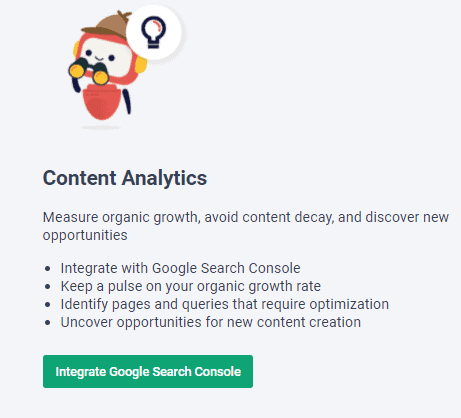
- Generate documents for up to five target keywords: The rest of the tools on this list will only have you specify one keyword per report. With Frase, you can specify three queries, and with its SEO Add-on, you can specify up to five keywords to optimize for.

Pricing Plans
- Free Trial with limited document credits.
- Basic Plan: $44.99/month —This plan is great for freelancers who don't have a team and only generate around 30 documents per month.
- Team Plan: $114.99/month — This is worth considering if you need unlimited documents per month and only one to three user seats. It’s sufficient for those who don't have multiple teams.
If you choose the Frase SEO Add-on, the cost is $35/month, on top of the Basic or Team Plan.
- Enterprise Plan: Custom pricing — If you need unlimited features and have an agency with multiple content teams, you may wish to request a quote.
Frase’s budget-friendly pricing model makes it a great choice for freelancers or solopreneurs who are just starting out. The company offered an AppSumo lifetime deal in the past, so keep an eye out for future offers.
What’s Left To Improve
Data:
- Frase only scrapes the top 20 search engine results pages (SERPs).
- Sometimes it creates keyword combinations that sound absurd.
- It doesn’t show a target readability score to meet.
- There are times when average word counts aren’t realistic.
User Experience: Frase needs a better in-app tour of how to use its product. At first, new users might not understand all of its features without watching the demos. Another downside is that it can’t generate bulk reports.
Best Use Case
- Topic research tool.
- Automated content briefing.
- AI writing assistant.
I love how Frase continually adds more features and makes it competitive to the other two content optimization tools on this list (which are most commonly used for enterprise-level needs).
Now, let’s talk about MarketMuse.
MarketMuse
MarketMuse is an industry-leading AI content planning and optimization software for SEOs or content teams. By analyzing thousands of articles across the web, the platform helps you plan and craft your content comprehensively.
The company says data scientists, engineers, and SEO experts helped build MarketMuse. So, there is no doubt that it offers useful features.
Key Features
- Research Application: The tool will display a topic model organized by relevance and typical topic distribution based on the search term you enter. You can choose the terms you want to include in your content and create an outline you can export immediately.
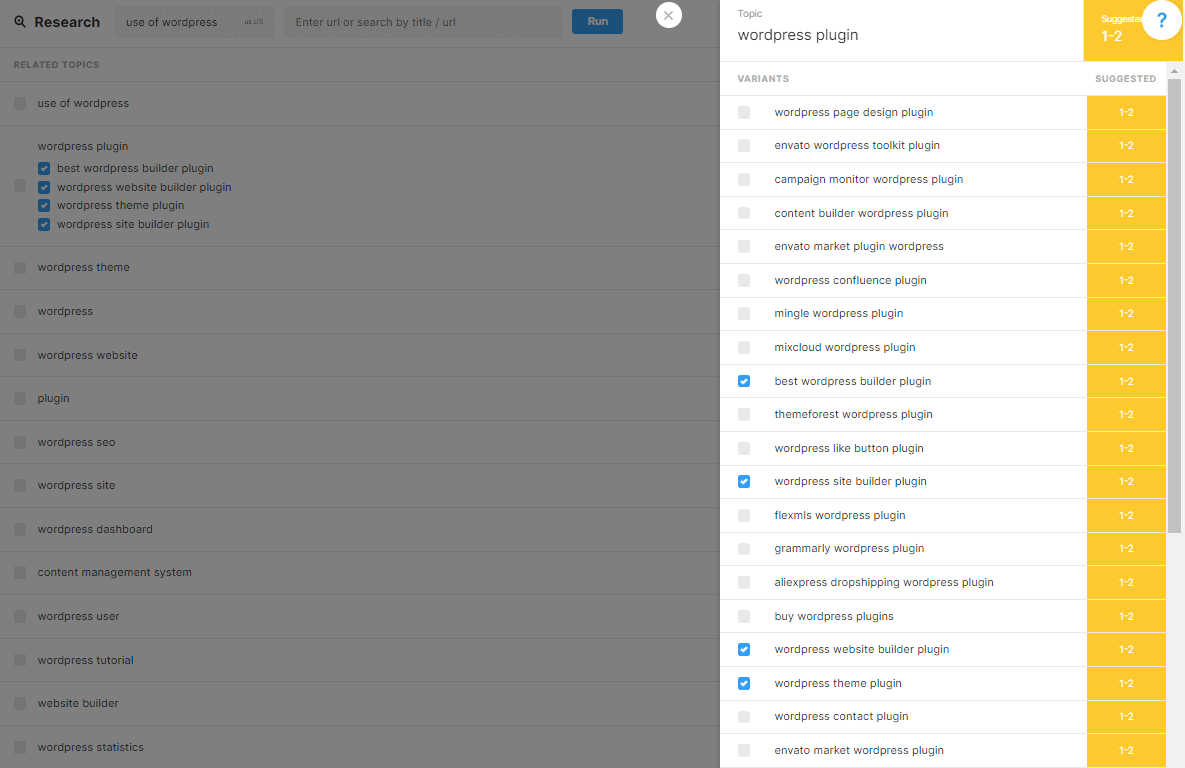
- Compete heatmap: This is one of the tool’s most popular and helpful features. It shows competitor topic gaps and you'll see where you stand in the competitive environment.
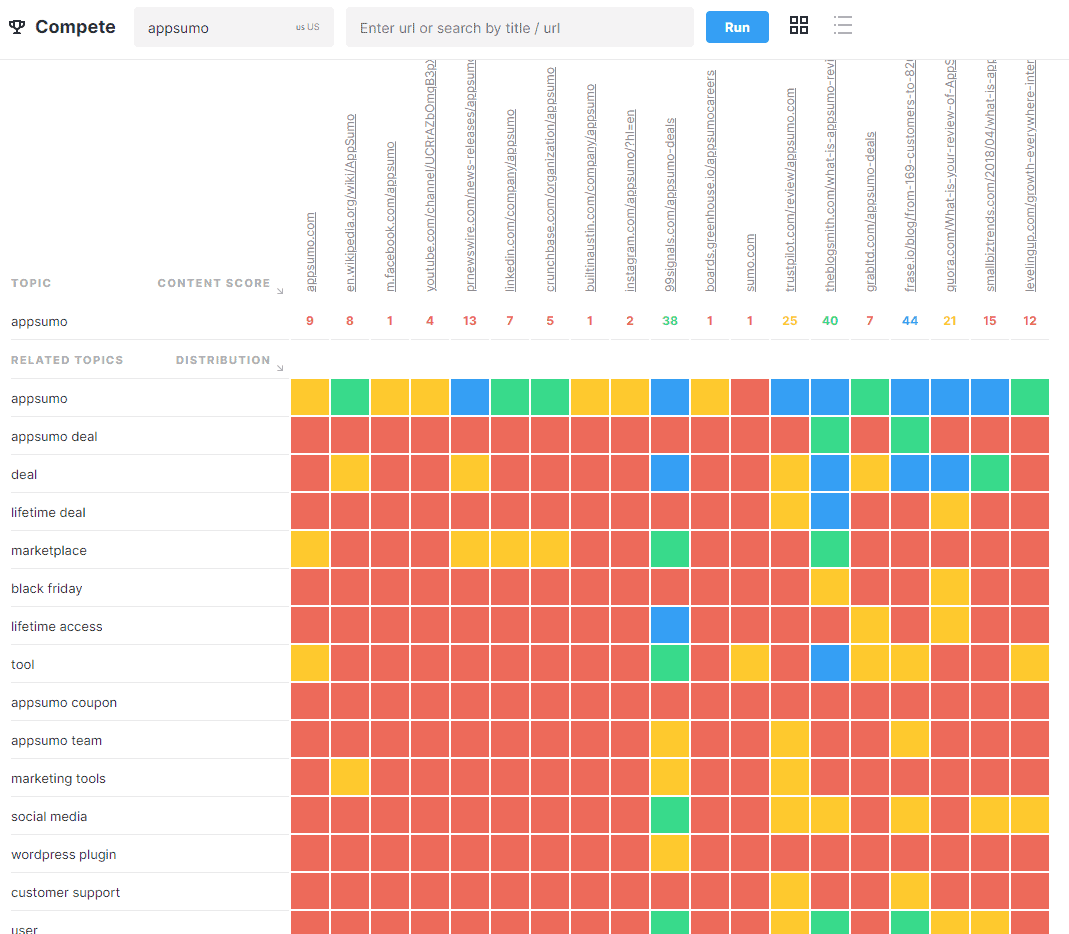
- Optimize feature: This optimizes published or unpublished content.

- Questions ideas: The software pulls related questions using a given keyword. If you have a question that you're interested in, you can run it on a separate MarketMuse application for further research.

- Connect feature: Since MarketMuse empowers you to connect domains under your account, it can recommend internal and external links to use in your article.
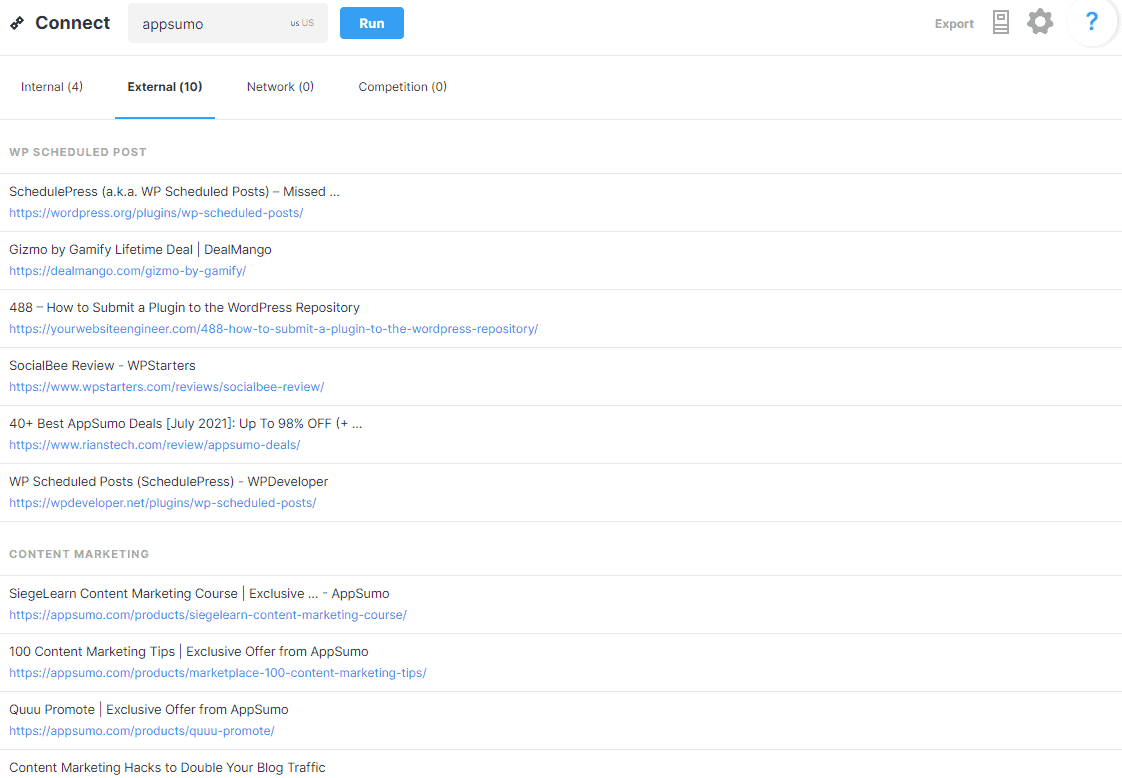
- Content Brief: MarketMuse lets you create customized briefs if you want to outsource an in-depth article to a writer.
What's Different
- Comprehensive data analysis: Unlike Frase and Clearscope, MarketMuse’s analysis is based on thousands of articles.
- Expandable topic models: MarketMuse groups every keyword recommendation across its application to a topic model. By showing you which clusters you are going to target, the tool is a great way to publish more content.
- Detailed content brief: The content brief creation is comprehensive, as it lets you carefully select the subheadings and related topics you want included in your content.
- Advanced settings to include or exclude content types: Frase and Clearscope do not have options to include and exclude content such as people and brand names or only scrape articles. Because MarketMuse offers this feature, you can avoid pulling data from competitors’ header and footers.
Pricing Plans
MarketMuse plan starts at $0/month with limited features, and plaid plans starts at $7,200/year . Paid plans get you unlimited projects — but it’s incredibly pricey for small businesses.
The Standard plan only allows one user seat, and adding new users costs $99 per month.
What’s Left To Improve
- The paid plans are too restrictive.
- It only supports five languages.
- No clear in-app instructions on how to use a certain feature. New users will need some training.
- The internal link suggestions are usually irrelevant.
- Its base plan should support collaboration functionality, like integrating with Google Docs or WordPress.
Best Use Case
- Content planning and strategy for a website’s overall topical relevance.
- Detailed content briefs.
- First drafts.
- Topic clustering.
MarketMuse and Clearscope seem to have overlapping pricing differences, so let’s see how Clearscope compares.
Clearscope
Clearscope is an AI-powered content optimization tool that has helped companies across the world produce highly relevant content for their target customers. It uses Generative Pre-trained Transformer 3 (GPT-3) technology, a new version of NLP that analyzes high-quality content from search engines.
Clearscope is a popular choice because it provides the most valuable SEO data to write content and win against competitors. Plus, it is straightforward to use. Here are its features:
Key Features
- Relevant terms: Clearscope serves as an SEO accuracy booster with the help of the measurements it presents on the Heading Presence, Typical Uses, and Importance tabs.
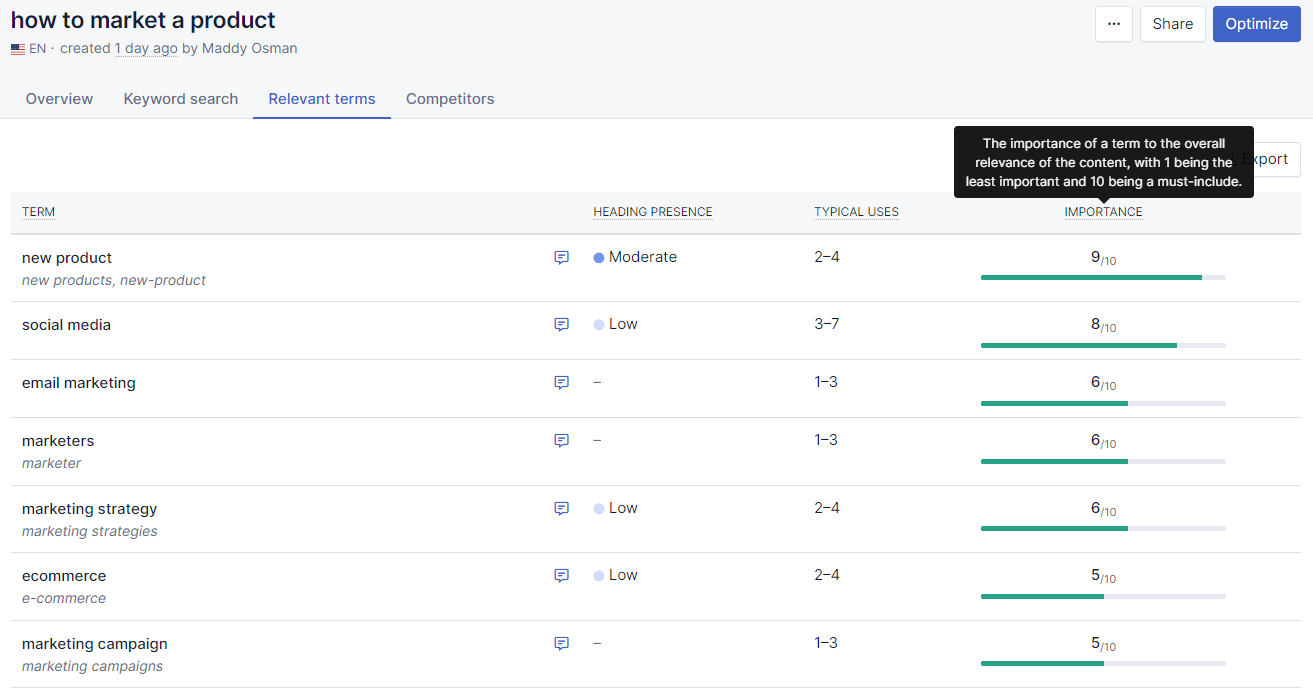
- Keyword research tool: You can filter keywords or questions by Monthly Search Volume and Competition analysis. You can also set several criteria, including:
- Most Searched
- Least Searched
- Most Competitive
- Least Competitive
- Highest CPC
- Trending

- Competitor analysis: Not only does this feature show Readability and Word Count, but it also displays a standardized Content Grading score across competitors. Plus, you have the option to show desktop and mobile rankings, which can help you determine your ranking strategy.

- Easy-to-use content editor: Clearscope’s text editor lets you review all the most important information at one glance. You can filter the Terms by Importance, Unused, and Heading Presence.
In the Research tab, you can see Related Questions, Top Competitors, and External Sources, all in one place.
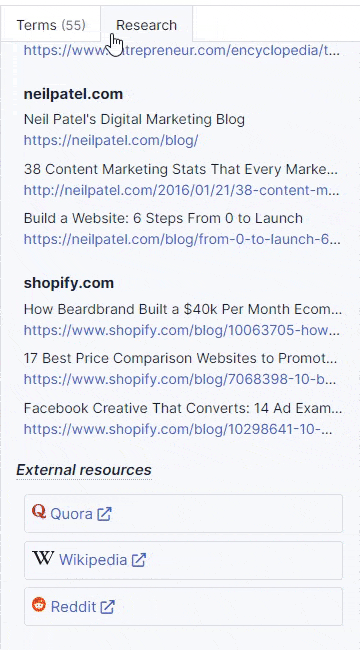
- Clearscope ecosystem: Integrates seamlessly with Google Docs and WordPress.
What's Different
- Bulk report feature: Clearscope empowers you to generate several reports at once.
- Easy-to-use integrations: It offers both a WordPress plugin and a Google Docs add-on, completely free.
- Easy access to external sources: Get everything discussed on Wikipedia, Quora, and Reddit, all in one link.
- Clear in-app instructions: There is information throughout the app's interface to help guide users with every feature.
- Content grade: Among the content optimization software reviewed here, only Clearscope provides a content grade to follow when optimizing content.
Pricing Plans
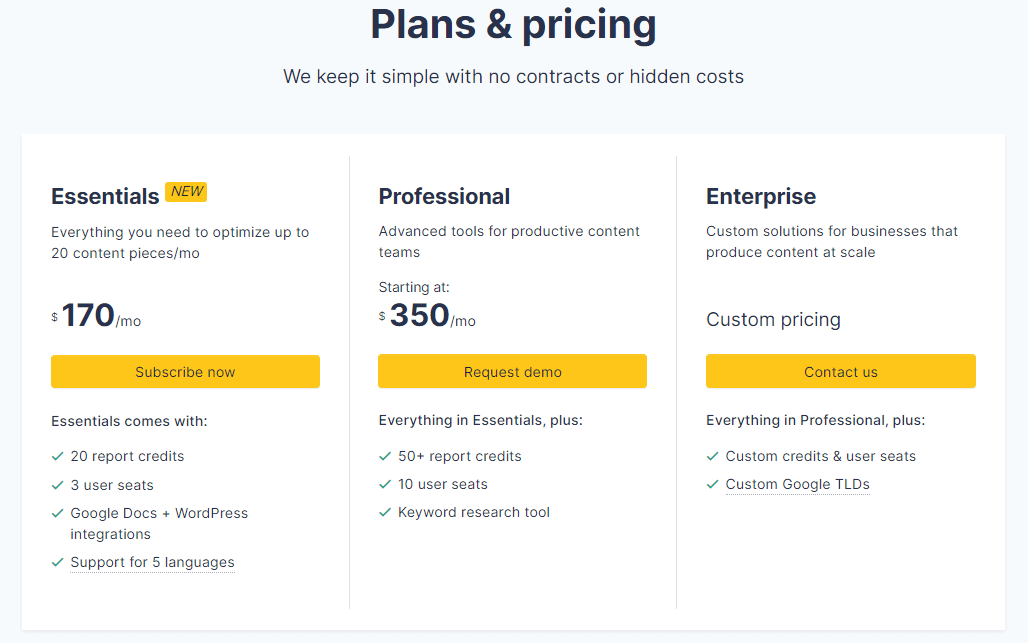
Clearscope plan starts at $170/month with 20 monthly reports but with three user seats.
Since Clearscope only lets you generate 20 credit reports (compared to MarketMuse which allows 50 reports at $179), the tool uses its own way of structuring credit models.
You can buy credit reports in packets of your choice for only $8.50 each, which is cheaper than MarketMuse’s $25/credit.

As far as pricing models go, MarketMuse and Clearscope are mostly meant for people with teams, not solo content creators or freelancers.
What’s Left To Improve
- No free trial.
- Only analyzes the top 30 searches on Google. It would be better if the data sources were expanded to compete with MarketMuse.
- Only supports five different languages.
Best Use Case
- Content optimization.
- Platform integrations.
- Keyword research.
- Outsourcing SEO content at scale.
Final Thoughts: Top 3 Favorite Content Optimization Tools — An In-Depth Look
So, how do you choose which content optimization software is best for you?
Your personalized needs usually determine what the right choice is.Therefore, let me reiterate the best use cases and my unbiased opinion.
You should use Frase if you are just starting out and need more topic research.
MarketMuse and Clearscope are great enterprise-level solutions. MarketMuse works best when you conduct a comprehensive content strategy and topic clusters to determine a website’s topical relevance.
Lastly, use Clearscope if you have larger teams to ensure you outsource SEO content creation at scale without the need to train employees.
It’s best to use all of these tools to take advantage of each unique feature. Several tools have emerged recently, and I’ve tested some of them, but most aren’t high quality. At The Blogsmith, we use Clearscope, MarketMuse, and Frase because their features add a unique value to our content creation service.
Do you have any questions about these content optimization tools? Let me know in the comments or contact us for more SEO professional advice.

